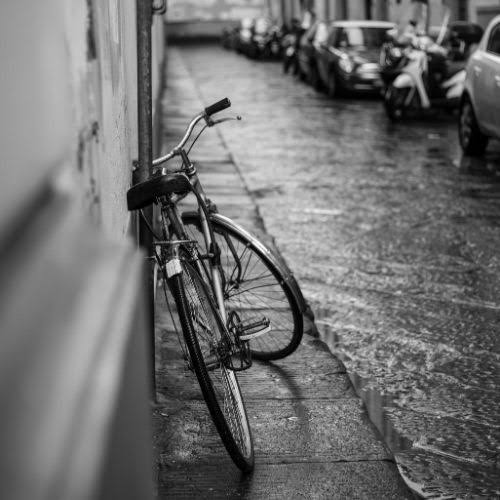If you commute with your bicycle daily, chances are you have been rained on several times. As much as you may try to beat the rain, sometimes it gets you off guard. Cycling with wet clothes is a story for another day.
Today, we want to know if rain is bad for your bicycle. I write about other interesting topics too.
There are differing opinions over this matter. Some think it is fine to have your bicycle rained on. Others think it is bad to leave your bicycle outside in the rain. Whatever your opinion, here is a researched answer to this question.
Leaving your bicycle in the rain is bad for your bicycle but not as bad as may imagine. A bicycle will run perfectly well after it has been rained on. However, if you can avoid leaving your bicycle outside when it is raining, then do it. It is good for your bicycle to stay dry. It is not a fish!
What Damage Does Rain Cause on My Bicycle?
Rain is just water, what damage can it cause? Rain can cause no significant damage on your bicycle. Most bicycles today have proper coating on metallic parts to prevent them from rusting. It takes very little time to apply lube to your drive train. Other turning parts are safe from rust unless you are really careless.
The big issue comes if your bicycle is exposed to the rain frequently and there is zero maintenance. This is more a problem of maintenance than rain. Your bicycle will only rust if you leave it exposed to the elements for long periods.
However, it is advisable to wash your bicycle with clean water after it has been rained on. Rainwater may be acidic sometimes and therefore, has a greater tendency to cause rusting. Also, rainwater may carry sand particles into the frames of your bicycle. This happens especially if you ride through stagnant rainwater.
Occasionally, do a thorough cleaning of your bicycle especially the parts that you normally don’t wash during normal washing. The dirt particles accumulate with time and if not removed may cause corrosion in the hidden areas.
What To Do When Your Bicycle is Rained On
In the event that your bicycle is rained on, the following are the safe procedures you need to take to minimize any future damage.
Cover the Saddle
Unless you are riding your bicycle, the first thing to do when it starts raining is to cover your saddle. Most bicycle seats are waterproof but it may have openings that allow water to seep in. If your saddle gets wet, you may have to cycle while standing all the way home. Bike seats that have an exposed sponge are even more vulnerable.
Wipe Your Bicycle
Immediately it stops raining, get a piece of cloth and wipe your bicycle. Make sure all the parts are free from the rainwater. Pay more attention to parts that are more likely to rust. Some of the parts you must wipe are the pressure valves, the front and rear derailleurs, the saddle post, the seat clamp, the chain, and the bike frame.
Wiping the chain has to be last because it will smear your piece of cloth with grease. However, if your chain is properly greased, you don’t have to wipe it. Just shake it to remove the excess rainwater sitting on it. Be sure to apply some more lube after that.
When wiping, remember to dry your rims especially if you are using rim brakes. When the tires are wet, rim brakes tend to lose traction. This means that you have to be careful when braking. If you have disc brakes, wipe the discs and all the brake components.
Sometimes, the disc brakes produce noise when they are wet. The noise vibrates your bicycle. You can minimize that noise by drying the disc brakes.
Turn Your Bicycle Upside Down
Rainwater may seep in the bike frame and cause internal corrosion. Therefore, turn the bicycle upside down for a few minutes to remove any water that may have seeped in. Often water seeps into the bike frame where the saddle post and the bike frame meet. The water then accumulates at the bottom of the frame causing corrosion.
Try to grease the internal parts of your bike frame if it is made of steel or aluminum at least once every year.
Dry the Bell
If you have a mechanical bell, chances are when it is wet, it produces less sound. A mechanical bell creates sound when a metallic part hits the gong. The sound plus the echo is what produces the ringing sound. When the bell is wet, the echo is minimized and the sound is not as loud as when the bell is dry.
Therefore, when your bicycle is rained on, make sure you wipe the bell and dry it. If you are using a digital bell, make sure you cover it. Any exposure to water may damage it.
Apply Lube to Moving Parts
Apart from minimizing friction, lubricants coat the lubricated parts from corrosion. Therefore, make sure you apply lube to all moving parts of your bicycle after it has been rained on. If the parts already have lube, don’t bother to add any more.
The critical parts that need lube are the brake handle hinges, exposed screws, and the chain. Exposed screws need lubrication to prevent them from rusting. If they corrode, you will have a difficult time opening bolts.
Conclusion
It is no big deal when your bicycle is rained on. However, avoid leaving your bicycle in the elements as much as you can. It is safer to ride in the rain than to leave your bicycle stagnant in the rain. If your bicycle is expensive or you just love it so much, then consider buying a waterproof bicycle cover for it. A bicycle cover is very cheap and it does a good work in protecting your bicycle from the weather elements.



